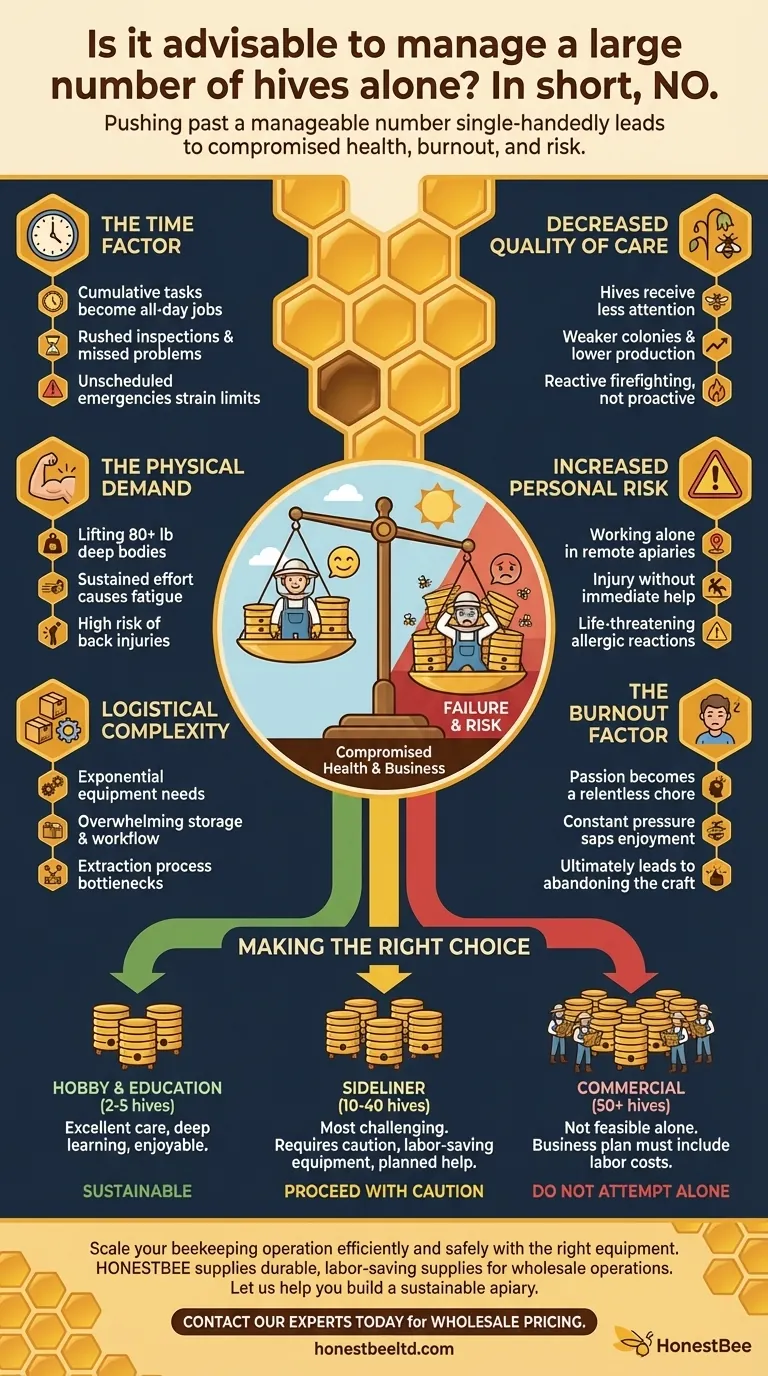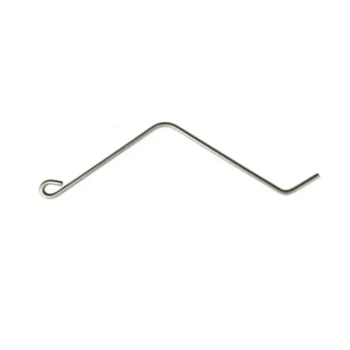In short, managing a large number of hives alone is not advisable. While a highly experienced and efficient individual might handle 20-30 hives, this number represents an extreme upper limit, not a recommended target. Pushing past a manageable number single-handedly often leads to compromised hive health, beekeeper burnout, and significant personal risk.
The question is not "How many hives can a person physically manage?" but rather "At what point does the quality of care for each hive begin to decline?" For a solo operator, that point arrives much sooner than most expect.

The Core Factors Limiting a Solo Beekeeper
The number of hives you can effectively manage is not a static figure. It's a dynamic limit determined by three key resources: your time, your physical capacity, and your logistical infrastructure.
The Time Commitment per Hive
Beekeeping tasks are cumulative. A 15-minute inspection for one hive becomes a multi-hour commitment for ten, and an all-day job for twenty.
Key tasks include routine inspections, feeding, mite monitoring and treatment, swarm prevention, and honey harvesting. When a problem arises—like disease or a queen failure—it demands immediate, unscheduled attention, further straining your limited time.
The Physical Demand
Beekeeping is deceptively strenuous. A deep hive body can weigh over 80 pounds (36 kg), and a super full of honey can weigh 40-60 pounds (18-27 kg).
Managing many hives means repeatedly lifting and moving these heavy boxes, often in hot weather and awkward positions. This sustained physical effort leads to fatigue and increases the risk of back injuries, especially when working alone.
Logistical Complexity
Scaling up hives creates an exponential increase in equipment management. Ten hives require vastly more storage space for spare boxes, frames, and extraction equipment than two hives do.
You must have a system for storing drawn comb, cleaning and repairing equipment, and managing the honey harvest and bottling process. Without a well-organized workflow and dedicated space, logistics can quickly become overwhelming.
Understanding the Trade-offs of Scaling Alone
Attempting to manage too many hives single-handedly forces you to make compromises, often with negative consequences for both your bees and yourself.
Decreased Quality of Care
When you are stretched too thin, hives receive less individual attention. You may rush inspections, miss the subtle early signs of disease or pests, or fail to act in time to prevent a swarm.
This can lead to weaker colonies, lower honey production, and higher winter losses. Your role shifts from a proactive manager to a reactive firefighter, constantly trying to solve problems that could have been prevented.
Increased Personal Risk
Working alone with many hives, particularly in remote apiaries, introduces serious safety concerns. A fall or a back injury can leave you stranded without help.
Furthermore, the risk of a severe allergic reaction (anaphylaxis) is always present. A high number of stings, which is more likely when managing many agitated colonies, can trigger a reaction even in individuals with no prior history of allergies. Being alone makes this scenario life-threatening.
The Burnout Factor
What begins as a passion can quickly become a relentless chore. The constant pressure of hive maintenance, emergency calls, and the physical grind can lead to beekeeper burnout. This saps the enjoyment from the craft and can ultimately lead you to abandon it altogether.
Making the Right Choice for Your Goal
The "right" number of hives is one that aligns with your goals and respects your personal limits. Use the following guidelines to find your sustainable number.
- If your primary focus is hobby and education: Stay within the 2-5 hive range. This allows you to provide excellent care, learn bee biology deeply, and thoroughly enjoy the process without it feeling like a job.
- If your primary focus is becoming a sideliner (10-40 hives): This is the most challenging solo range. Proceed with caution, invest in labor-saving equipment, and have a clear plan for seeking assistance during peak seasons like honey harvesting.
- If your primary focus is a commercial operation (50+ hives): Do not attempt this alone. Solo management at this scale is not feasible or safe. Your business plan must include labor costs from the very beginning.
Ultimately, successful beekeeping is about finding the right balance between your ambition and the well-being of your bees.
Summary Table:
| Factor | Key Limitation for Solo Beekeepers |
|---|---|
| Time | Tasks like inspections and treatments become all-day jobs, leading to rushed care. |
| Physical Demand | Lifting heavy boxes (80+ lbs) alone increases fatigue and injury risk. |
| Logistics | Equipment storage, honey extraction, and workflow management become overwhelming. |
| Safety | Working alone raises risks of injury and severe allergic reactions without immediate help. |
Scale your beekeeping operation efficiently and safely with the right equipment. Pushing beyond a manageable number of hives alone compromises bee health and your safety. HONESTBEE supplies durable, labor-saving beekeeping supplies and equipment to commercial apiaries and distributors through wholesale-focused operations. Let us help you build a sustainable and productive operation. Contact our experts today to discuss your specific needs and wholesale pricing.
Visual Guide

Related Products
- HONESTBEE Premium Italian Style Hive Tool with Hardwood Handle
- HONESTBEE Advanced Ergonomic Stainless Steel Hive Tool for Beekeeping
- HONESTBEE 15-in-1 Beekeeper Multi-Tool with Hammer and Pliers for Beekeeping
- Professional Galvanized Hive Strap with Secure Locking Buckle for Beekeeping
- Versatile Ratchet Hive Strap with S-Hooks for Secure Fastening
People Also Ask
- How is a hive tool used for scraping and cleaning? Master Hive Maintenance for a Healthy Colony
- What are the benefits of a multi-functional hive tool? Streamline Your Apiary Workflow with One Tool
- What are some common uses of a hive tool? Essential Multi-Purpose Tool for Every Beekeeper
- What is the hive tool used for? The Essential Multi-Tool for Every Beekeeper
- What maintenance steps are recommended for hive tools? Ensure Longevity & Apiary Health



















